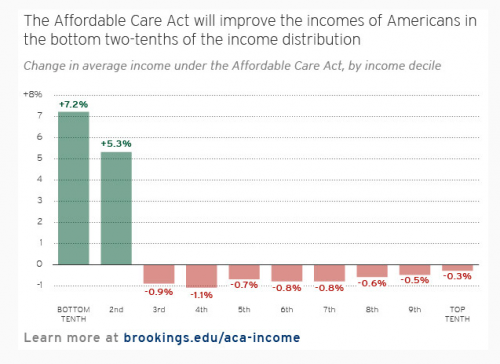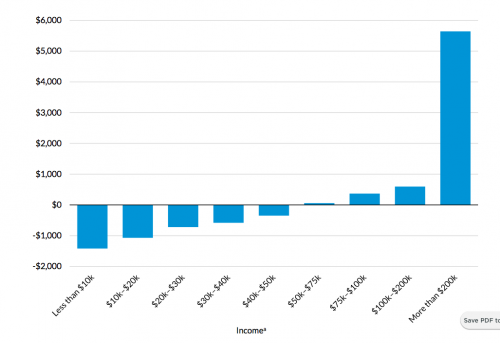The House passed the American Health Care Act (AHCA) this afternoon. It’s still a considerable way from becoming law, but if it does it will repeal the Affordable Care Act (ACA). Here are two charts that explain why this happened.
The first chart is from Henry Aaron of the Brookings Institution (previously discussed here). For each decile of the US income distribution, it projects the income gains and losses from the ACA, where the cash value of the health insurance benefit is treated as income. The positive bars on the left are income gains by the people in the lowest 20% of the US distribution. They are balanced by losses in the upper 80% of the income distribution.

Next is a similar chart from the Urban Institute on the net transfer effects of the AHCA.

The horizontal axis on the Urban Institute graph represents income ranges, not income deciles. The four bars that are positive on the right represent people making $50,000 or more (the upper 37% of the US income distribution). The bar on the far right, with the huge positive income transfer, represents people earning $200,000 or more (the top 0.33% of the income distribution). Notice also that the vertical axis of the Brookings chart represents percentage changes in income, whereas the axis in the Urban Institute chart represents changes in dollars. If you converted the Urban Institute chart to percents, the magnitude of the bars on the left (low) side would grow and those on right (high) side would shrink. The Institute projects that the average person earning $200,000 or more will get a 1% increase in income. They project that the average person earning less than $10,000 will experience a 33% net loss of income. Think about that for a moment.
Here is why the AHCA is moving forward. The ACA used tax funds to pay for the healthcare of people in the bottom 20% of the income distribution. High earning people pay most of the taxes, so the ACA transferred money from them down to people in the bottom deciles of the US economic hierarchy. The AHCA cuts taxes in the ACA and reduces the amount that the government will spend on the health care of the poor. The net effect of the AHCA is a massive loss for the poor and a benefit for the very top of the economic scale.
I would love to be able to say that these bills represent clashing views about the best way to deliver health care. Unfortunately, I am unable to find a conservative health policy expert who thinks the AHCA is optimal. There may not be one who thinks it’s even good. The AHCA did not pass based on its merits as a health policy solution. The AHCA passed because Republicans wanted these transfer effects.

